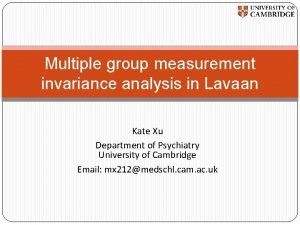Measurement Invariance of the Pediatric Version of PROMIS

- Slides: 1

Measurement Invariance of the Pediatric Version of PROMIS Symptom Scales between American and Chinese Children with Cancer 1, * Yuan ,Pamela Changrong S. , Yanyan , Jichuan 1. School of Nursing, Second Military Medical University, Shanghai, China; 2. Children’s National Medical Center; 3. Department of Pediatrics, School of Medicine, George Washington University, Washington DC, USA Abstract This study assesses measurement invariance of the symptom scales (i. e. , anxiety, depression fatigue, and pain) of the pediatric version of Patient Reported Outcomes Measurement Information System (PROMIS) between American and Chinese children with cancer. Our results show that the four PROMIS symptom scales have adequate structural validity in both American and China populations of children with cancer. Though a few item thresholds and factor loadings were found noninvariant, overall it is plausible to say that the measurement of the two PROMIS scales are invariant between the China and American populations of children with cancer. 2, 3, Hinds 1 Liu 2, 3 Wang Insert Affiliate Logo Here Results • All the models fit data reasonably well in both China and the U. S. populations. All the models have RMSEA<0. 08, Close-fit P-value>0. 05, CFI>0. 90, TLI>0. 90, and WRMR<0. 90. • The model fit of all the full measurement invariance models seems acceptable. • A limited number of item thresholds (21 out of 136) in the four PROMIS symptom scales were found noninvariant across populations (see Table 1). • All the factor loadings of the Depression scale are invariant across populations; one noninvariant factor loading was found in the Pain scale (i. e, Pain Item 1), and two in the Fatigue scale (i. e. , Fatigue Items 1 and 10). However, there were three non-invariant factor loadings in the Anxiety scale (i. e. , Anxiety Items 2, 6, and 8). • Residual variance, factor means and factor variances of the four PROMIS scales were not significant between the China and the U. S. cancer patients. Sample A total of 256 children and adolescents with cancer were recruited from two cities (Shanghai and Chengdu) in the China sample between May, 2012 and November, 2012. A total of 203 8 to 17 year olds were recruited from five geographically diverse settings in the U. S. sample: Children’s National Medical Center in Washington, DC; Nebraska Medical Center in Omaha, Nebraska; Children’s Hospital of Los Angeles in California; Palmetto Health Children’s Hospital in Columbia, South Carolina and Emory University in Atlanta, Georgia. Statistical Analysis • Confirmatory factor analysis (CFA) model with categorical items were conducted to examine factorial structure of the PROMIS symptom scales by populations. • The “Top-down” approach was applied to test item thresholds and factor loading invariances between the two populations using multigroup CFA with categorical items. • Invariance of residual variances, factor means/variances were tested. • The robust WLSMV estimator was used for model estimation with delta parameterization. • Mplus 7. 1 was applied for modeling. Discussion • The four PROMIS scales all have adequate structural validity in both the Chinese and the U. S. populations under study. • The full measurement invariance models are acceptable; however, partial non-invariance in item thresholds and factor loadings were identified in the four PROMIS symptom scales. • Nevertheless only a very limited number of measurement parameters were identified non-invariant in the PROMIS symptom scales; thus violations of measurement invariance in the scales are of minor importance. • Overall, it is plausible that measurement invariance of the PROMIS symptom scales would likely remain between the China and American populations of children with cancer.

